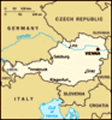Advertisement
Published: March 22nd 2018
The weather forecast today called for slightly warmer temperatures, with a bit of sunshine in the afternoon. But as we would soon discover, low 30s and the wind in our faces while walking made for a chilling experience. So this morning, in an effort to minimize walking, we opted for a taxi ride (instead of the tram) to reach the Belvedere palaces and museum, located on the southeastern edge of the city center.
The two Belvedere palaces, referred to as the Upper and Lower, were built in the early 18th-century by the famous Baroque architect Johann Lucas von Hildebrandt to be used as the summer residence of Prince Eugene of Savoy (1663–1736). The entire complex, including extensive gardens, is one of Europe’s most dazzling Baroque landmarks, and is listed as a UNESCO World Heritage Site.
Prince Eugene had a lasting influence on politics, as well as on Austria’s art and cultural history. After being rejected from Louis XIV’s army as a young man, he fled France and entered the service of Emperor Leopold I’s army. He eventually attained fame as a general and diplomat, traveled widely in Europe, and cultivated contacts with prominent personalities. A network of his agents
and friends helped him amass a collection of paintings by Dutch, Italian, and French masters.
The Belvedere now houses the greatest collection of Austrian art dating from the Middle Ages to the present day, complemented by the work of international artists such as Claude Monet, Vincent van Gogh, Edvard Munch and Pierre-Auguste Renoir. But the principal attraction, and the reason for our visit, is the world’s largest collection of Gustav Klimt’s paintings at the Upper Belvedere.
Quite aside from the palace's many artistic masterpieces, several of the palatial-size rooms qualify as works of art themselves, with the Marble Hall (and its ceiling frescoes), being perhaps the most impressive. The four massive statues supporting a stuccoed, vaulted ceiling in the Sala Terrena (ground floor hall), and the octagonal Palace Chapel, are also stunning.
With twenty-four of Klimt's works, the Belvedere holds the world’s largest collection of oil paintings by this iconic artist, including the two masterpieces from his Golden Period,
Kiss (Lovers) and
Judith, major portraits (Sonja Knips, Fritza Riedler, and Johanna Staude etc.), landscapes, and allegorical depictions. But the collection’s undisputed star attraction is Klimt’s world-famous masterpiece the
Kiss, an allegorical depiction of lovers locked together in

 Judith
Judith
Gustav Klimtan embrace.
Gustav Klimt (1862-1918) was a symbolist painter, and one of the most prominent members of the Vienna Secession movement. Klimt is noted for his paintings, murals, sketches, and other objets d'art. His primary subject was the female body, and his works are tinged with eroticism. In addition to his figurative works, which include allegories and portraits, he also painted landscapes.
In 1897, Klimt became one of the founding members of the Wiener Sezession (Vienna Secession), whose goals were to provide exhibitions for unconventional young artists, to bring the works of the best foreign artists to Vienna, and to publish its own magazine to showcase the work of members.
This group of artists split-off (or "seceded") from the conservatism of the Vienna Society of Visual Artists (Künstlerhaus). The Secessionists pursued the goal of an artistic renewal, with one of its priorities being to establish a forum for the international
avant-garde, redefining Austrian art in the process. Klimpt remained with the Secession movement until 1908.
We spent over 2-1/2 hours exploring all three levels of this magnificent palace, and the numerous paintings and sculptures displayed throughout. The exhibits in each of the many rooms were well
marked, with English and German descriptions, as well as thematic story boards that give historical context for the various artistic periods and movements that inspired the works on display. After viewing Klimt's masterpieces, Dee concluded that she admired his
Judith most of all.
At this point, it was 1:00 PM, so we decided to have lunch at the Café Menagerie, a cute little place on the ground floor of the palace that is operated by an outside vendor. The menu was pretty simple, with several typical Viennese dishes on offer. Dee ordered the goulash soup, while I wanted to try some
wurst (sausages). For dessert, we shared a lemon tart, and drank an espresso and a cappuccino.
We exited the palace via the north facade, walking through the gardens toward the Lower Belvedere. The air temperature was still in the 30s, with the wind in our faces, and by the time we reached the lower palace we were freezing. So, instead of our original plan to visit the Naschmarkt (a famous street market on the southwestern side of the Ringstraße), we switched gears, and then caught the tram to do some shopping at the supermarket near the apartment.
Dee's comments: I love Vienna in the springtime...when it's snowing...I love Vienna when it's freezing...NOT! We were off in the cold morning air, but took a taxi today, yeah! Another interesting day, and I loved the Klimt paintings.
The sun made an appearance at 4 PM, just as we were walking to the tram station; nice ride. But the conductor made an announcement toward the end of journey that we couldn't understand, and then veered from the normal route; we got off, found our bearings, and had to walk a few extra blocks to get to the grocery, then home to defrost!
I find Vienna to be a very clean city, including the trams.
Advertisement
Tot: 0.126s; Tpl: 0.013s; cc: 9; qc: 30; dbt: 0.0354s; 1; m:domysql w:travelblog (10.17.0.13); sld: 1;
; mem: 1.1mb


























joyce....
non-member comment
"is she a chicken ?!??!!!"
I do believe the word should be tweeze...NOT Pluck.... unless in reference to nose hairs!!! LOL